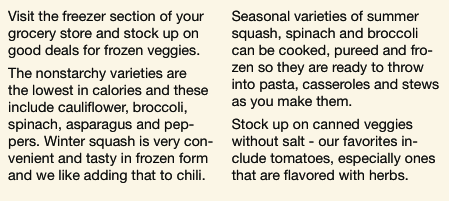Food News: Up with Purees
 Researchers at the University of Pennsylvania completed a study1 that shows that hiding veggies in foods is an effective strategy to get people to eat more veggies and significantly fewer calories. This is because nonstarchy veggies are the foods that are the lowest in calorie density. For example, lettuce is a lot lower in calorie density than refined starch, fatty meets, cheese and many other common foods in our marketplace.The researchers wanted to find out whether or not they could make a difference in their subject’s calorie intake by adding pureed vegetables to foods to lower the calories and calorie density of the meals. They realize that many people eat too many calories and not enough vegetables. The subjects ate as much as they wanted for breakfast lunch and dinner in the lab for 3 weeks. The subjects ate meals that were either standard 100% or containing two different variations of vegetable purees: 75% and 85%. They rated hunger before and after they ate.The researchers found that they could decrease calories by 200 to 350 when veggies were added. The more pureed vegetables added meant more calories reduced. The ratings of hunger did not change significantly. The amount of calories consumed from veggies varied between 270 and 487.Researches concluded that large amounts of pureed veggies can be incorporated into various foods to help decrease calories and to get everyone eating to increase their vegetable intake.1. Blatt, A. D., Roe, L. S., Rolls, B. J., Am J Clin Nutr April 2011 vol. 93 no. 4 756-763 http://ajcn.org/con- tent/93/4/756.short?rss=1The types of dishes that lend themselves well to the addition of purees include:• soups and stews• casseroles• pasta dishes• chili
Researchers at the University of Pennsylvania completed a study1 that shows that hiding veggies in foods is an effective strategy to get people to eat more veggies and significantly fewer calories. This is because nonstarchy veggies are the foods that are the lowest in calorie density. For example, lettuce is a lot lower in calorie density than refined starch, fatty meets, cheese and many other common foods in our marketplace.The researchers wanted to find out whether or not they could make a difference in their subject’s calorie intake by adding pureed vegetables to foods to lower the calories and calorie density of the meals. They realize that many people eat too many calories and not enough vegetables. The subjects ate as much as they wanted for breakfast lunch and dinner in the lab for 3 weeks. The subjects ate meals that were either standard 100% or containing two different variations of vegetable purees: 75% and 85%. They rated hunger before and after they ate.The researchers found that they could decrease calories by 200 to 350 when veggies were added. The more pureed vegetables added meant more calories reduced. The ratings of hunger did not change significantly. The amount of calories consumed from veggies varied between 270 and 487.Researches concluded that large amounts of pureed veggies can be incorporated into various foods to help decrease calories and to get everyone eating to increase their vegetable intake.1. Blatt, A. D., Roe, L. S., Rolls, B. J., Am J Clin Nutr April 2011 vol. 93 no. 4 756-763 http://ajcn.org/con- tent/93/4/756.short?rss=1The types of dishes that lend themselves well to the addition of purees include:• soups and stews• casseroles• pasta dishes• chili